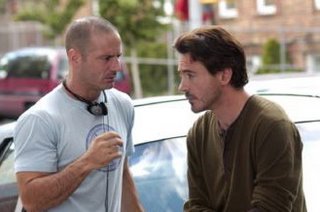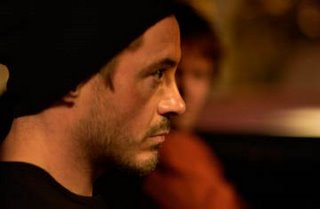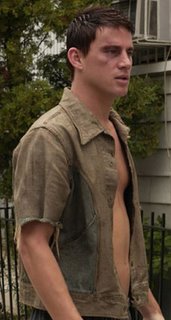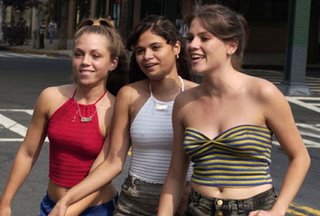
Dito Montiel is Bruce Weber material. He's got a square jawline, masculine face, buffed body. In his shorts, sweatshirt and stocking cap, he looks like a Calvin Klein ad (which he's actually done with Mr. Weber). He's also made noise in a hardcore punk band, signed with David Geffen for some good coin, and impressed Liza Minnelli. I mean, dude!! Now he's raising eyebrows with the film adaptation of his first book, A Guide To Recognizing Your Saints. The film's just opened in New York and David Hudson has gathered up what appear to be consensual raves at Greencine Daily (all save for Salon's cautionary Andrew O'Hehir who doesn't feel like giving away his heart too soon). Despite Andrew's sage advice, I am admittedly smitten. Then again, I'm just old enough to enjoy feeling my pulse quicken. Dito, and his San Franciscan editor Jake Pushinsky, shared their enthusiasm with me in Dito's charmingly messy room at the Hotel Monaco.
* * *
Michael Guillén: First and foremost, congratulations on winning Best First Director and Best Acting Ensemble for A Guide To Recognizing Your Saints at Sundance. That's a notable achievement for a first time effort. I'm excited to talk to you today, partly because my last interview was with Paul Rachman for American Hardcore, so I thought, "What a perfect segue."
Dito Montiel: [Chuckles.] Yes, it is. I'm in American Hardcore, diving off the stage to the Bad Brains.
MG: You are?! I didn't know that.
Dito: He told me. I'm so looking forward to seeing that scene. I'm sure it will be a blur of some crazy kid. I haven't seen it yet. I'm always about five minutes behind them.
MG: You have such a rich and varied life experience—but, since we've touched upon that—it's my understanding that as a young kid you were part of a hardcore punk group called Gutterboy?
Dito: They weren't really a hardcore band. The hardcore band I was in was called Major Conflict, which is a typical hardcore name, ridiculous.
MG: Why I bring it up is that the DIY aesthetic—the "Do It Yourself" aesthetic—presented and promoted in American Hardcore, I feel like you've applied that in every medium you approach. You did it with your book. And now you've done it with this film based on the book. You've in essence done both the book and the film yourself. Am I correct in assuming you're still practicing that hardcore DIY aesthetic?
Dito: It seems corny and weird, but there was something very special about the birth of that [hardcore punk scene] that never left me. When I was 13 years old I went to the Village in New York because I was from Queens and the Village seemed like—well, my friend had a magazine called Punk Magazine. We were too young to be part of the punk Sex Pistols scene but I was blown away by the photographs. I was like, "Who are these people?" I had to know who they were, y'know? I know out here in San Francisco you guys had Dead Kennedys, you had a big scene—
MG: Which terrified me. I was such a wuss.

Dito: [Laughs.] Oh yeah? But in New York you didn't even know what you were looking at because the hardcore scene was tiny and barely non-existent. So I went down to the Village with my friend Ray—who we still talk every day; we're still best friends—we were looking for the Village; it's absurd. I ran into this guy who was from Queens also who was in a hardcore band called Urban Waste and he said, "Y'know, I'm quittin' this band and you guys are from Queens, we rehearse over in the projects in Ravenswood, why don't you be in the band?" So Ray said, "I can play drums." "Okay, you're the drummer; I'm the singer," and he looks at me and he goes, "What can you play?" I'm like, "Nothing." He says, "I have a guitar; you'll be the guitar player" and I said, "Okay." We went to the Ravenswood Projects that night and I just made a bunch of noise and four days later—it was like a Tuesday—that Saturday we played the A-7 Club in New York, which was the little hardcore place, and it was terrible. It was just a whole bunch of crazy noise. I couldn't even play a bar chord. It was the best experience of my life and I never ever forgot it. Nothing ever changed me the way that moment did. In the long run now I look back and I think, that was the moment for me. I had friends who were in bands that they rehearsed for five years in their basement until they perfected every Led Zeppelin riff and I used to say, "When you guys gonna play?" and they'd say, "We almost got it down." It was really exciting and that thing never left me to some degree. I always made noise and I always will and I enjoy it.

I started writing one day because it felt good and I guess, if things feel good, they're therapeutic. That's sort of the way I believe life is, right? It feels good to write and so one day it was long enough to be a book. Luckily, some guy I used to work with at Tower Records—it's a weird world—got a job at a publishing company and he read what I wrote and he said, "We'll put it out." Then along the way that turns into somebody who says, "Let's make a movie" and it felt good so, sure, let's go do that. It's funny, this is my friend Jake who's from San Francisco, he cut the film and he'd never edited a film before. We were working in a dub room together and we had this crazy little dream that we were going to make a movie and now there's a movie.
MG: That inspiration comes across. The rawness of that if-it-feels-good-let's-do-it enthusiasm comes across and makes for an exciting movie. I write a lot about the religiosity of memory, how by looking back you sanctify events and people, and that's exactly what you've done with Saints. You've created this—you call it "guide"—as if you're trying to show people not to abandon or forsake their memories, even if they're uncomfortable ones. Was the character of your same name in the movie pretty much like yourself? Or is the character fictional?
Dito: Whenever you write it's always a combination of both, I guess. Even if you're writing about King Kong, you're probably going to put yourself in there somewhere. In this one I put a little more of myself than normal.
MG: I guess what I'm really asking is if the tension that drove Dito away from his Queens upbringing to a writer's life in Los Angeles was biographical?
Dito: The big plan we had for this film that was the most important thing to come across in it was that it was a movie filled with love. It was a beautiful place that bad things happened in. People always talk about the Kennedys. "Oh, the poor Kennedys, they have such tragedy in their life" and my mother used to say, "They have 15 kids! What do they want? Everyone to be happy?" [Laughs.] The plan for this film—and it's probably a bit of myself in there—is that I feel blessed that I grew up with a lot of love—a crazy love—but a lot of it. And that's why I probably have had a pretty decent life because that's a nice thing to have as a kid; it goes a long way. I saw a lot of people that didn't have that situation and I don't know what that's like but—from an outside point of view—it seems pretty terrible. In making the film it was important that that came across. There were no villains in my movie. Just people. So there's a bit of myself in there, of course, and hopefully that shows.
MG: When you published the book, which was based on these personages from your past, was there any conflict at that time? Did people you wrote about say, "Hey, what are you talking about? This isn't who I was?"
Dito: Well, yeah, but more now because, at the time, no one saw the book. No one bought it, y'know? [Laughs.] So now it's all coming out and it's very odd. Boy, the movie opens today in New York and Los Angeles and it's going to be particularly [interesting] because we're going to see exactly how people feel. I wrote the book more about people I had met, not particularly myself, it's the stories … my impressions of what they meant to me. I don't try to say this is who they are. This is what they were to me, what they did for me, which was good, all good. I didn't have a vicious word to say about anyone in this book because they meant a lot to me. So I tried to say what they meant to the eyes of a 16-year-old kid looking at them. We'll see how that comes across because in the film we've mixed all different peoples' stories. I mean, there's a kid Giuseppe in the film who dies from getting hit by a train; my friend Giuseppe who most of that character is based on was deported to Italy for being arrested so many times…
MG: So he's alive and well in exile?
Dito: He's alive and well and he lives in Milano. We had a friend Billy who in the book and in life had died riding on the trains. Kids used to do that, which was crazy. So that's how the character [Giuseppe] dies. The movie was just in the Venice Film Festival in Italy. It won like the Critics Week. I called Giuseppe up there and I said, "You gotta come see the movie" and he said, "I heard I died!" He was all excited about it. So at least he's excited about dying; we'll see what everyone else feels. [Laughs.]
MG: That's like myself, I keep telling people that—if I were in a movie—I want to be in a monster movie where I get killed off in the first scene. For some reason this is one of my ambitions.
Dito: [Laughs.] Okay, I'm the guy to do it!
MG: Speaking of the character Giuseppe, was he insane?
Dito: He's a great choice because he is to me exactly the epitome of what this film has been in a strange way, his character, the journey of making this film. In real life, the friend that I had Giuseppe was out of his mind. [Chuckles.] But not in the way that this actor is.
MG: Giuseppe in the film was troubled.
Dito: Yeah. [My friend] Guiseppe was troubled in his own way. The kid I grew up with was in a terribly abusive home but he was hysterical. He was the funniest kid I ever met in my life. And he was like a cat. He could climb literally up the side of a building to the roof. I never saw a human that could do that. He would just go right up the building, up the bricks, right to the roof, like it was nothing, like a cat. So when I was writing the role for the film, there's a scene where he's in a train station and he pretty much commits suicide—we're not giving away the film, just that—but the way I wrote it was the way I remembered Guiseppe, he's like a cat, he's inside the tracks and he's joking around and at the last minute he's going to go right up and the train's not going to kill him. But then we wrote into the film that he slips and dies. So then the actor who plays him is named Adam Scarimbolo and Adam is similar to the role he plays—not that damaged, but—I found him on the streets of New York and he's a special kind of kid and we're hanging out and we start doing the scene and he's doing it like it's a suicide. I'm like, "Adam, this is not a suicide, remember? It's Guiseppe. He just gets up at the last second." And he's like, "Oh" and he kind of talks like the character in the film, "Well, I don't know." And I said, "Why are you doing it like a suicide?" He goes, "Well, my brother he won't say I love you so of course I kill myself." I thought, "Man, that's a lot more interesting than what I wrote." So I let him go with that. That was pretty much this movie in a nutshell. There's the real Guiseppe who's a cat who lives and is in Italy now and there was Billy who got killed by the train and then there's the actor who comes in and decides now it's a suicide. We went with the evolution of this film in a lot of ways.
MG: There's a lovely tension around language in the film. This is a good point on that. You have this wonderful colored language of the streets, this street cred talk that's so beautiful and expressive, and yet this inability of these kids (and for that matter Chazz Palmentiri as Dito's father) to articulate their feelings. It's an interesting tension. Myself, I come from rural background, but it was the same kind of tension, the same kind of colored language among the farm kids and yet an inability to speak what we were really feeling. I remember at that time, God, I would have loved to have lived your life in New York.
Dito: Well, I dreamt of farms my whole life. I really did.
MG: There you go. The excerpts I've read from your book—and, I'll be honest, I haven't had a chance to read the book—but the small bits I've sampled, they remind me—and I hope this isn't insulting to you—of the teenage heartthrob romances that Laura Nyro used to sing a lot about in her songs.
Dito: There's certainly no way I could take offense to that!
MG: Well, you never know. I know that for myself growing up in the country when I used to hear these Laura Nyro songs with Labelle talking about going down to the street tunnels to sing, it's the life I wanted and it's why I moved to a city. I think the movie has this glamorization of urban youth growing up on cityscapes. It's being compared to some of the best films, early Scorsese, early Larry Clark, and I can see why: it has that raw street aesthetic to it. Now, the casting is incredible. You won the award for ensemble acting. Robert Downey, Jr. is one of my favorite actors. I watched the movie because Robert Downey, Jr. was in it and he delivers, again, a remarkable performance. My understanding is he met you at one of your bookstore readings?

Dito: Robert's so funny. He loves to create crazy fables wherever he can. The last one—he called me the other day to tell me that he had told an interviewer that we met at a zoo—so he said, "Look for that one coming your way!" [Laughs.] The way we met was, over the years it was impossible to not bump into each other. Me and Robert traveled in strange circles and eventually we were going to crash into each other, and we did a bunch of times. We had a mutual friend [Jonathan Elias] who actually ended up doing the score for the film. Me and Jake, the editor, were working together in a place in Los Angeles. The guy who was good friends with Robert was our boss so Robert would come in and out all the time. We had done this weird little short film with a video camera, and a little portable tape player—not as fancy as that [he gestures to my digital recorder]—and put it on a screen, and started messing with weird ideas. We were in a dub room all day. Jake was figuring out how to edit on a computer at the time. We put it in there and started putting sounds and weird things to it. Robert came in one day and we said, "Hey, take a look at this." He looked at it and he's particularly arty enough, and cool enough, and privileged enough also that he said, "Wow." He read the book and he said, "Why don't we make a movie?" Of course it becomes a long crazy story from there. The funny thing I say all the time about Robert is—I bring his name up and, wherever I go, the first thing anyone says is he's a great actor and then they say, "Is he crazy?" They want to know all the dirt. I tell them all the time, "Do you know how many great actors get one DUI and that's all they're ever known for?" He's still a great artist first and I do believe it's because he'll take a chance and he took a chance on pretty much two first-time guys who had no chance on earth of ever making a "real" film that I'd be talking to you about that would be in a theater. We were going to make this movie regardless of Robert Downey, Jr. or not but it probably would have been on video and we would have it screening at a friend's house. Luckily, someone like him comes along, and it catapults things. It's scary also because now we have to get film; how we going to afford that? It becomes a long process but, luckily, there is privilege that comes with someone like Robert. He is an artist first and that's why we all still know his name, not because of all the weird stories about him, but we still think of him as a great actor first and I really think that comes because he's an artist.

MG: Having had similar issues as Robert's, I appreciate that he has survived the chances he's taken in life and carried on to do such great work. The big breakout performance in Saints is Channing Tatum's.
Dito: Certainly.
MG: His stunningly virile performance in Saints leads me back to talk a bit more about the hardcore punk scene, specifically something I didn't have the chance to ask Paul Rachman when I interviewed him, which I'll ask you: the hypermasculinity of the hardcore scene and in your film, is glamorized, almost eroticized. Was it like that on the streets? Was that toughness a glamorous ideal?

Dito: Channing, in particular, what he did with the role was special. I didn't want Channing at first because he sounded all wrong to me. I had found this kid in the street that was the perfect messed-up mangled kid that was impossible to love that reminded me of the person I was writing about. Channing is a Bruce Weber model who is as goodlooking as a guy can possibly be, he's six foot tall, he's from Alabama, it makes no sense that he's in this movie and I'm like, "No, this is crazy." Then the thing that was really special about him and I am so glad that he ended up in the film is because—to answer part of the question—he went from being this great looking guy to a wounded, sort of beautiful person for me. That's difficult. He brought this Mice and Men quality to the character that I wrote that was slightly more interesting than what I think I wrote. He brought a guy who breaks your neck and then tries to put it together because he didn't mean to do that. As far as the hypermasculinity, the strange thing that happened with him that was really important with this film in every aspect of the word and way was one of the first scenes we're filming, he's walking down the street where he sort of beats this kid up and he just does this dumb little thing as he's walking down the street….
MG: …and he's laughing.

Dito: And he's laughing and everything. We're walking away—and, of course, because we're filming in the neighborhood where a lot of these things took place, there's always critics everywhere and directors all over the streets—and one of them walks over afterwards and he says to Channing, "I knew Antonio and he would have spit in that guy's face and thrown him over that thing and laughed all the way home." Channing, of course, was worried about that. I said, "That guy would have made a terrible film" because he thought Antonio the character was a big joke. He thought he was out there to amuse everyone. Antonio was a wounded person. When he laughed, he laughed because it was pain. He did these things because he was doing the right thing. It didn't seem like the right thing but he believed they were. That hypermasculinity in the hardcore scene is another story. Maybe similar in a way, but, there's just a truth to what we tried to get and what Channing brought to that character that was … I don't know if it's all real. The truth isn't always real.
MG: That's an astute point. If you're going to sanctify these memories and these people in your past, especially if they've been so violent, you did Antonio a good turn. You remembered your friend well even if you fictionalized him a bit because he came off sympathetic. We all would want to escape that kind of a past and some of us are more fortunate than others in the ways we find to get away from difficult beginnings and to transform our pasts into something more notable. A writer sifts the beauty out of the past to give it meaning. That's the value of being a writer and a filmmaker. May I ask Jake a question?
Dito: Please.
MG: This is your first time editing?
Jake Pushinsky: Yes.

MG: I was intrigued by the sequence where, after telling the story for a while, you then film a series of straight-on portraits of each of the characters where they reveal something about themselves in one line or so. The young Laurie says that everyone she loves will leave her. The young Antonio admits he's just a piece of shit. How did that idea come about?
Jake: Originally Dito had all the kids on the set and thought, "Maybe we'll use this." It wasn't in the script. "Maybe we'll use this at some point. I want to have each of the kids come up, say their name, and say this one line. They reveal something about their character without saying something completely obvious." There was no plan on where that was going to go in the film. When I got the footage in the cutting room, I played around with it for the beginning, for the end ….
Dito: Putting Nina Simone to it.
Jake: Putting Nina Simone for the finale of the movie. Where now we see all of the kids [to the song of] "We're Back in the New York Groove", there was one time when it was a Nina Simone song and the kids saying their thing. We came across to the middle of the movie and actually came across a tough transition going from a scene to a scene and this was when everything was really falling apart—or it was about to fall apart; it hadn't really happened yet in the film; I don't want to give away too much—but, we get to a part in the film where we've seen things and we've started to get to know these people and a lot of major stuff is about to happen. It felt right to throw it in there. It really was something that we just dropped in there to see if it worked and it stuck.
MG: For me—in terms of the saint metaphor—it was like you were lighting candles. This is Saint Laurie. And this is Saint Antonio. It was a moment of honoring them.
Jake: Yeah. We've seen these kids living this life and going through their everyday thing and it was more like here is what they're really thinking. They really do know what's going [on]. In the way that Dito was just saying about Antonio, he wasn't there to amuse people.

Dito: He thought he was a piece of shit. The only reason [this sequence] even got filmed was because we're hanging out and Channing is trying to do an actor thing, which sometimes I have a hard time buying into but I'll play the game. [Channing] says, "What does Antonio think about himself? Does he think he's the baddest motherfucker that ever lived?" And I was like, "No. I mean, he used to mutter all the time, 'I'm a fuckin' piece of shit.' He hated his life." [Channing] goes, "Really?" I'm like, "Yeah. You know what? So as an experiment," I said, "why don't you walk down the hill, tell the camera you're a piece of shit, and tell everyone what you think, remember that house you're walking by, it's a house of friggin' hell, it's a hell house." So he starts doing it and we're like, "Man, that looks pretty good." So then we have all the kids do it. When Jake got it, that's when we started saying, "Man, maybe we'll use this."
MG: It worked. At that moment when Antonio says that, my heart opened to him and I got him. Not that I excused his violence, but I got him. Another interesting edit for me—being that this is a film based on your own book and I'm often intrigued by how writers adapt their own works into films—is the sequence where what is being said is being typed on the screen. What inspired you to do that intriguing bit of intertextuality?
Dito: Jake can give you specifics; I'll give you the broad terms. Every single thing that the two of us did in this film, everything, we'll sit here and we can explain every cut to the point where we can bore you to tears. We know why every cut happened. But the easy answer is it felt right. Everything felt right. Nothing is in this film because it looks cool. That might be why we started experiments with it—hmmmm, this is kind of fun and cool—but it goes back to what I was saying before: if it's fun, there's something relieving about it. So we kept trying to have fun with this film and not just fun but to give a point to everything we did. Whenever something felt right, that's why it's in the film. Some of them we can explain to little detail but some it just felt, "I don't know why it's going to be here but it feels right."
Jake: Years ago when we started playing around with the idea of this film and we did a little short five-six minute thing, there was a real conversation with the real Antonio that we had on tape. We were grabbing anything and everything that we had to make this little short film, any sound, any music, any visual. I went to New York on a trip by myself and had a little Bolex camera and got on the subway and filmed the dirt spot and we used that in the short film and then it ended up the idea went into this film. So we had this real conversation and it sounded so great but—if you just hear it, it's almost nonsense, it's two people talking and talking fast and you don't really understand what they're saying—but we wanted to use it and I was playing around with things and we tried it over endless visuals and it just got lost and it was too good to lose and I thought….
Dito: And it wasn't like anything particularly important was being said.
Jake: Nobody says anything; it's how they say everything that they don't say. A.O. Scott nailed it on the head when he said Chazz Palminteri says, "You're not going anywhere, Dito" but what he means is, "Please don't leave me." It's how he says the things that they don't say. This was the same thing with that original conversation. I just played around with: what if we see what they're saying? That way, as a viewer, you can't take your eyes off of it and then it gives it that much more importance.
Dito: Even though nothing's being said. So much is the underbelly of it.
MG: But it underscores what you're doing as a writer, that you remembered, that you listened, and that you made this necessary leap to type it out and put it down on paper, which is what sanctifies things; it takes it to a different level.
Dito: That's what I'm saying about the strange thing about—when you go with the feeling, in writing, or making or movie, or whatever art one creates—it takes on incredible meaning everywhere. I hear people say things about the film that I think, "Wow…"
MG: I should see that film.
Dito: [Laughs.] Like lighting the candles. We didn't think of that at all but it makes perfect sense. We weren't that smart to have thought of that being a reason.

Jake: It's one of those things I feel like with any art, if somebody puts their feeling and heart and emotion into it, other people are going to feel that also. They can take it however they want to take it, and get whatever they get out of it, but, our goal was to make something that for us we watched and loved and felt good about. We feel that way about this film and, hopefully, everybody else will get—whatever they want to take from it—but that they feel that there is that true emotion to it. We loved the typed writing in the short but when it came down to the film, if it didn't work in the film, we weren't going to put it in there.
MG: Final question. I read somewhere that your idea of a good movie is a black detective, a white woman and a serial killer.
Dito: [Laughs.] I hate 'em but I love 'em!!
MG: Are you going to do one?
Dito: [Laughs.] You mean make one? Maybe. Hey, I'd love to, but, we'll see.
MG: Any plans on the horizon?
Dito: I have a book coming out called The Clapper. It's about a guy who's a paid audience member in Los Angeles who gets paid $50 to clap and laugh at terrible t.v. shows that aren't funny. We're a bit obsessed with trying to make that a film next.
MG: Well, good luck with that, and congratulations again on A Guide To Recognizing Your Saints.
Cross-posted at Twitch.









